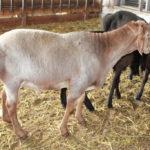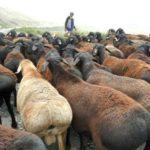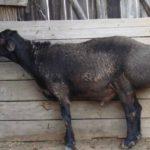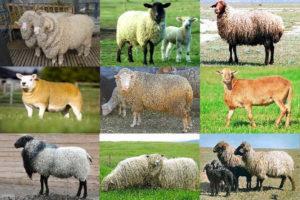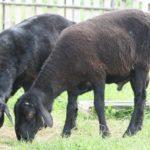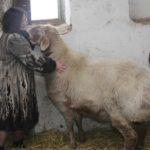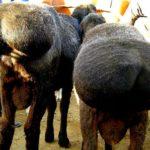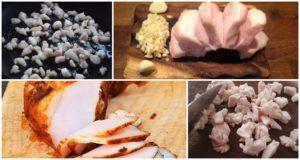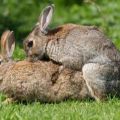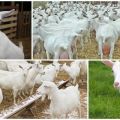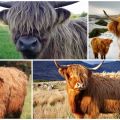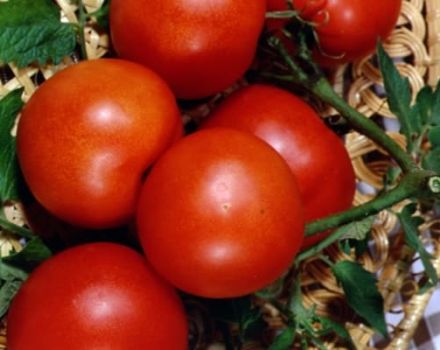Description of fat-tailed rams and how they appeared, top-5 breeds and their features
The fat-tail domestic ram is an amazing sight. Nature has endowed the animal with a unique ability to accumulate nutrients for future use. This mechanism allows the pet to get through difficult times. Ancient nomads noticed the unusual property of the sheep in time. As a supplier of meat, lard, milk and wool, a fat tail animal is of particular value to humans.
Origin
Fat-tail rams have long been popular in Asian countries. In those distant times, the territory of Central Asia was inhabited by nomads. For eternal travelers, there was only one available craft - cattle breeding. People were faced with a difficult task, because the arid climate and lack of water negatively affected the quality of the grass, so it was difficult to keep livestock.
As a result of evolution, animals appeared that were able to do with scanty food for a long time, but at the same time quickly gain weight and store fat. Thus, people received a lot of meat, wool and valuable fat tail fat. With the help of the latter, travelers managed to preserve meat for a long time. The fat acted as a preservative.
Today fat-tailed sheep are found in the North Caucasus, Kazakhstan, Pakistan, Crimea and Afghanistan. Sheep are increasingly found on the farms of North Africa. Due to their specificity, sheep have not become widespread in European countries, in addition, animals are poorly adapted for modern methods of animal husbandry.
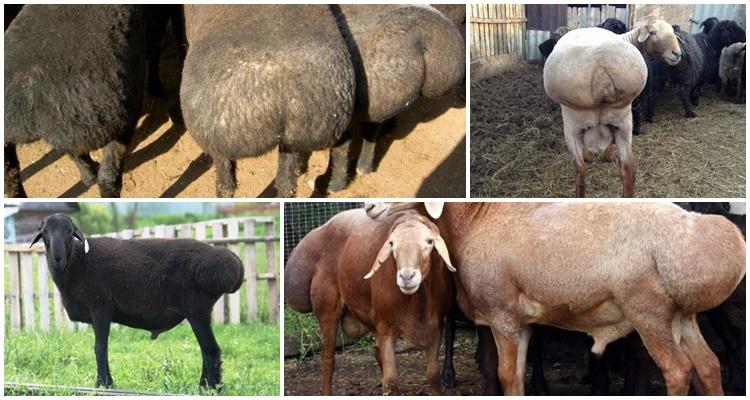
General description and characteristics
The fatty deposits concentrated in the sacrum are distinguished from the curly counterparts of the fat tail ram. These reserves of bacon form a large bag - a fat tail. Its size depends on the species and sex of the animal, the weight of the fat tail freely reaches 5-10 kg. The fat tail contains many useful substances, moisture and nutritious fat. Like camels, pets can take advantage of natural storage in case of drought or famine.
The fat tail fat is strikingly different from the internal fat supplied by ordinary animals. It melts easily, has a pleasant buttery texture and is healthier than regular lard.
Representatives of different breeds of fat-tailed animals have common features and characteristics:
- Sheep are impressive in size. The growth of the pedigree ram reaches 100-110 cm, the female grows up to 80-90 cm.
- A fat tail is an integral part of the body of all representatives of an unusual species of sheep.
- The pets are very massive. The weight of the male often reaches 150 kg, the ewe gains about 60 kg. Lambs are rapidly gaining weight and reach 40 kg by 1.5 years.
- In most cases, animals are hornless (hornless), but occasionally there are owners of horns.
- The narrow, hook-nosed head and drooping long ears give the pet a touching appearance.
- The coat is coarse, bristly, devoid of fluff.
- The tail of an animal is modest in size, only 8-10 cm.
- The color of the pet is often red or light brown. White, black or gray individuals are often found.
Fat-tail rams are genetically adapted to a meager food supply, therefore they can easily get by with stunted vegetation and, like many centuries ago, wander along with their owners.
Breeds of fat-tailed sheep
In places of traditional breeding of fat-tailed animals, there are many varieties of unusual rams. Some of them are especially popular:
- Hissar sheep. The animals are successfully bred on the territory of Uzbekistan and Kazakhstan. Massive handsome men rarely get sick and gain weight quickly. Rams of reddish-brown and black colors are more common. The coat is very hard and rough. Ewes easily gain 86-89 kg, the weight of an adult ram reaches 150 kg. For one cut, about 2 kg of wool is removed from the pet.
- Edilbaevskie rams. Edilbaevskie rams are distinguished by their strong bones, but they are slightly smaller than the representatives of the Hissar breed. The maximum weight of males reaches 120 kg, females gain 57-60 kg. Edilbaevites are found in the vastness of Kazakhstan, Bashkiria and Tatarstan. Pets are successfully bred in the Saratov region. The wool of rams is colored auburn or black. Each time, up to 3 kg of raw materials are cut from a pet. The meat of young animals has a delicate taste. During lactation, ewes give up to 100-110 liters of fatty nutritious milk. Pets of black color surpass their red relatives in fat tail size and the amount of wool.
- Kalmyk breed. Animals are common in the farms of Mongolia and China. The mass of a ram does not exceed 115 kg, a sheep weighs 73-75 kg. The breed is famous for its excellent meat quality and soft coat structure. The best raw materials are taken from black and white pets. Each cut brings up to 4 kg of the rune.
- Sarajin sheep. The Saraja sheep became widespread in Turkmenistan. Pets cannot boast of large sizes (ram weight - up to 90 kg, sheep - up to 59 kg), but they produce high-quality wool. From each cut, the owners receive 2-3 kg of fleece.
- Tushino breed. Half-tail sheep are found mainly on the territory of Georgia. The animal is well built, hardy, rarely sick. The weight of an adult ram reaches 70 kg, the ewes gains 37-40 kg. A distinctive feature of pets is a fat tail, similar to a puffy pillow. Tushins have wavy, elastic hair. The hairline grows up to 25 cm and contains up to 70% down. The rest of the fleece contains guard and transitional hairs. Each cut from one pet brings up to 4 kg of raw materials. Sheep milk and meat are of excellent quality.
Advantages and disadvantages
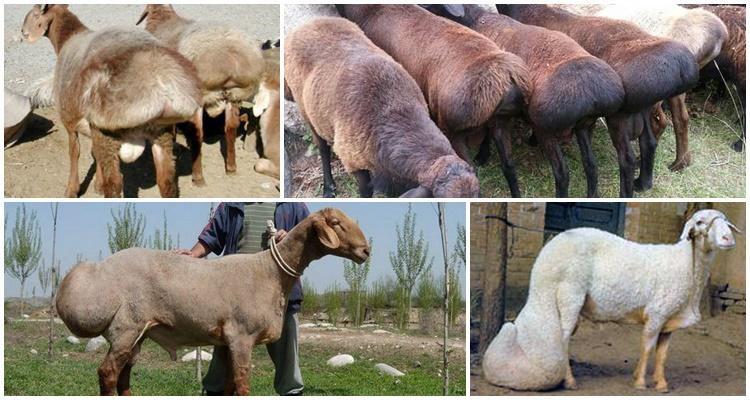
Breeding fat-tailed sheep is a promising business that promises considerable earnings. However, before starting work, you need to take into account all the advantages and disadvantages of animals.
Maintenance and care rules
In the warm season, pets are sent to pasture. They spend most of their lives there. Pasture should not be established in swampy areas, otherwise animals will feed on plants growing in acidic soil. Such food will inevitably lead pets to severe poisoning. In case of bad weather, a canopy is arranged for the wards. Pets spend night hours there.
With the onset of frost, the sheep are moved to a warm sheath. Any spacious, and most importantly, dry room is suitable for pets. Sheep quarters must be protected from harmful drafts and ensure good ventilation. Otherwise, pets run the risk of suffering from ammonia fumes.
Separate compartments are built for pregnant and lactating ewes with lambs. It should be warmer in here than in the room for other pets. Newborn lambs do well at 16 degrees. The air temperature in the main sheepfold should not fall below +10 degrees.
The floor is covered with dry grass or sawdust. This bed must be changed daily. The stalls are equipped with comfortable drinking bowls. Water must be changed 2 times a day. The premises are cleaned daily. The animals are periodically examined by a veterinarian. The specialist assesses the condition of the sheep and conducts routine vaccinations. In the summer they bathe the lambs. Water procedures are performed no more than 1 time in 1.5 months. A couple of times a year, pets are sheared and trimmed their hooves. Sheep wool is regularly treated for all kinds of parasites.
What to feed animals
In the summer, the wards are happy to use pasture. In winter, animals are transferred to a home diet. In the morning, pets are treated to solid food, lunch consists of concentrates, and in the evening the pets are content with hay. Experts forbid giving the wards sugar beets. The treat can cause diabetes in pets. You cannot treat sheep with frozen vegetables - the use of these products threatens the death of animals.
Breeding subtleties
The sheep reaches sexual maturity by 6-7 months. For successful breeding, the herd contains a pair of breeder rams. For mating, healthy, tall individuals are selected. The gestation period lasts 5 months. Labor is usually easy and painless. The newborn lamb is examined, the baby's nose and mouth are cleaned of mucus, and then returned to the mother. At one time, a sheep gives birth to 1-2 cubs. After 2 days, the lamb confidently moves after its mother.
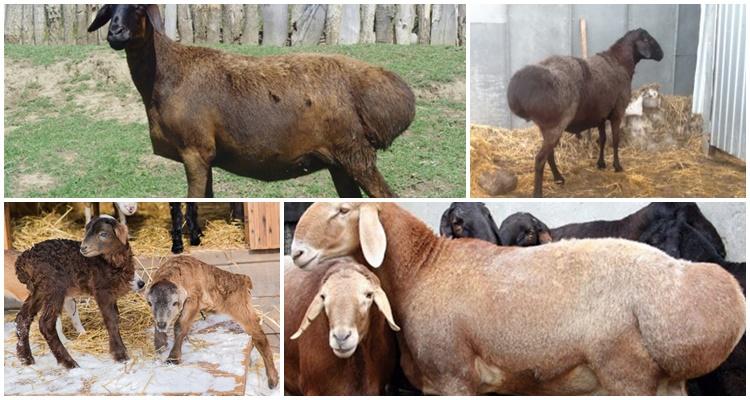
What are they sick with?
Despite the enviable endurance, pets can get sick. If you detect signs of malaise in time and contact your veterinarian, many troubles can be avoided.
- Helminthiasis. Pets often become victims of worms that parasitize the internal organs of pets. The diagnosis is made based on the test results. Symptoms of the disease: depression, poor appetite, diarrhea, hair falls out in small pieces. For treatment, antiparasitic agents are used.
- Scar flatulence. One of the most common ailments in pets. The cause of the disease lies in improper feeding of the wards. Symptoms: bloating and hardness of the abdomen, loss of appetite, anxiety. If you do not provide assistance in time, the animal will die. The problem is solved with a rubber probe. With the help of this simple tool, accumulated gas and remnants of undigested food are removed.
- Poisoning. Trouble happens as a result of the ram eating poisonous plants. Symptoms: high fever, vomiting, diarrhea, loss of appetite.Treatment consists in urgent gastric lavage with a special solution. The product is prepared from 0.5 glass of vegetable oil, 0.5 l of water and 50 g of salt.
The use of a fat tail in cosmetology and medicine
Fat tail fat has long been successfully used for the production of cosmetics. Beneficial substances help smooth and rejuvenate delicate facial skin.
Lard is used in the fight against colds. It is added to herbal teas, and is also used for wrapping procedures. Unlike lard, the contents of the fat tail are not salted. Fat tail fat successfully copes with diseases of the liver and gallbladder. The remedy has a positive effect on potency, relieves ulcers and gastritis, and also lowers blood sugar. Tail fat contains a record amount of vitamins and amino acids.
